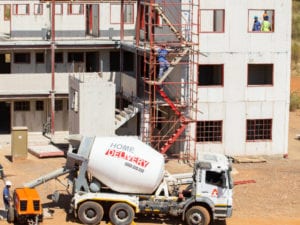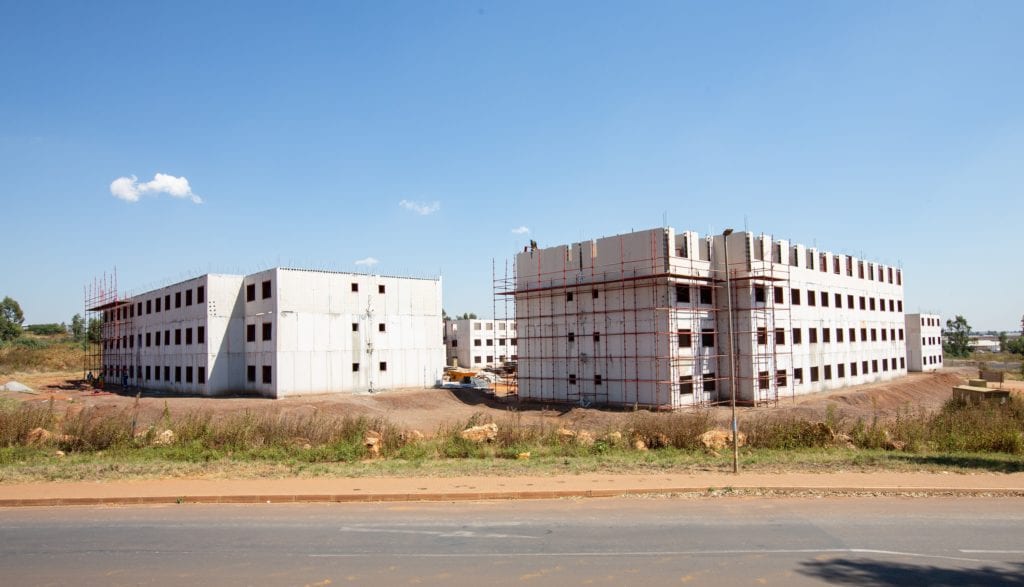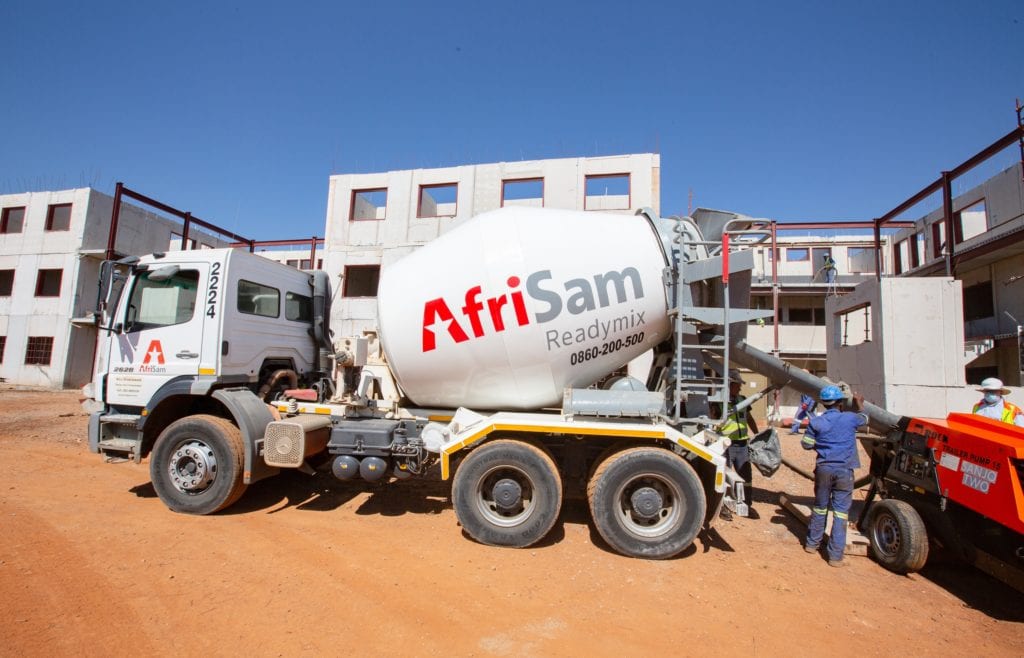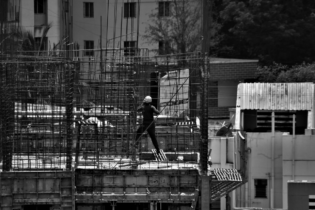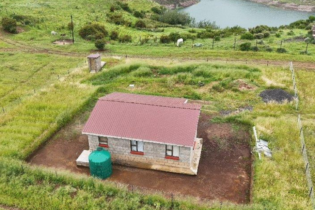Thembisa residents are among the first to benefit from an advanced, lightweight walling technology, which enhances the quality and affordability of residential apartments in a 500-unit project in Extension 27.
The four-storey ‘walk-up’ residential buildings in Thembisa are being constructed with the Sanjo Fabtech Sterling lightweight walling system, also used in the building of upmarket apartments and hotels in Sandton. Construction materials leader AfriSam has been working closely with Sanjo Fabtech Sterling to supply a specialised, lightweight concrete mix for the wall cavities. According to Jonathan Peel, director at Sanjo Fabtech Sterling, the walling system has enabled a fast-tracked and cost-effective project, which also deals with difficult ground conditions. The company is combining sophisticated, lightweight concrete mixes – designed and developed by sister company SanteQ Liteweight Building Technology – with its permanent formwork walling system. “Most importantly, the quality of the buildings in the Thembisa project exceeds what homeowners expect from a brick and mortar structure,” says Peel. “The system produces a robust structure, where the solid walls offer excellent sound and thermal insulation, as well as fire resistance.” The lightweight walling system comprises pre-engineered cellulose-fibre cement boards spaced apart by high-impact moulded inserts manufactured from recycled plastic. The void between the two layers is filled with the specially designed composite of recycled polystyrene, cement and admixtures. “The cured weight of the walls is between 550 kg and 1 300 kg per cubic metre, depending on whether it is load-bearing or not,” says Victor Bouguenon, director, SanteQ. “This represents a weight reduction of 50% to 75% when compared to traditional masonry materials, offering distinct design and engineering benefits.” In the Thembisa project, an important benefit was how this technology addressed problematic soil conditions on-site. Situated in a dolomitic zone, normal building would have required over-engineered and costly foundations. Using lightweight walling, however, significantly reduced the load on the foundations, with commensurate cost savings. Flexibility Peel highlights that the same walling system can be used for both exterior and interior walls, with varying infill densities and wall widths. In this project, the load-bearing walls measured 229 mm in thickness with a 1 250 density infill, while the internal walls were 112 mm thick with a lighter 500 density infill. The infill mixes offer significant weight reductions over conventional concrete. Due to the large volumes of lightweight concrete infill required by the project – over 6 000 m3 – AfriSam was requested to supply a readymix solution. According to Luigi van der Made, readymix operations manager, AfriSam, this involves delivering between 48 m3 and 102 m3 a day of SanteQ’s special mix in readymix trucks. “The polystyrene is added on-site and mixed thoroughly with the screw-type augers in our 6 m3 capacity readymix trucks,” says Van der Made. “The final infill mixture is then pumped into the walls, speeding up the construction process. We are able to deliver the supply from our Olifantsfontein operation, which is only 9 km from the construction site.” Innovation The high level of innovation in applying this technology meant that close working relationships were essential to success. AfriSam made its depth of technical concrete expertise available to test and ensure that SanteQ’s mix designs were suited to the readymix application and consistently applied. The mixing of the recycled polystyrene using readymix trucks was also a novel concept that required an inventive approach with special drum coating and polystyrene dosing equipment.“Managing the large quantities of polystyrene beads on-site has certainly been a new challenge for everyone,” he says. “These have to be carefully fed into the readymix trucks, while preventing them from escaping and becoming a source of pollution on-site and beyond.”
When returning to the AfriSam plant, it is also vital that the polystyrene left in the residual mixture in the drum does not contaminate any of the other concrete mixtures leaving the plant. This requires a fastidious cleaning process, which must be closely managed. “In line with our sustainability commitment, we have also been able to put in place a recycling circuit for the polystyrene washed out of our trucks at the plant,” he says. “Once extracted from the residual mix, these beads are rebagged and returned to SanteQ to be recycled.” Van der Made notes that a constant supply of high-specification product was ensured through four dedicated AfriSam trucks, to keep the project moving along at the expected pace. This had to be done while constantly ensuring the consistency, workability and cost-effectiveness of the infill mixture. The special lightweight concrete mix – which does not use coarse aggregate – includes a fine and coarse sand component, as well as fly ash with the cement. Chryso Omega 140 AFR ZA, a high-range water-reducing plasticiser, is also included to increase the slump while reducing the water requirement. He emphasises that SanteQ’s technical use of fly ash in the various lightweight concrete mixes has enhanced quality, lengthened the delays in setting time, and reduced the carbon footprint of the products. Local empowerment The Thembisa project has also been able to empower emerging local contractors, engage local labour and expose workers to skills and opportunities in the construction sector due to the simple construction method associated with the walling system. “With the requisite supervision and planning, contractors can use this walling technology to employ people without previous construction experience,” says Peel. “The walling systems are assembled and erected quickly and cleanly on-site, with minimal waste on prefabricated panels.” Electrical and plumbing services are pre-installed into the space between the fibre-cement boards, after which the infill is pumped into place and the joints skimmed. The uncomplicated design and quality manufacturing ensure that the walls are plumb and ready for painting, with no plastering required. So solid is the resulting wall that it can carry loads of up to 40 kg per point, using off-the-shelf wall plug and screw mechanisms. The surface of the board can be skimmed, tiled or covered with wallpaper, wood panels and other materials. By facilitating a consistent build quality, the system helps to keep programme timing and budgets predictable and on track, says Peel. “Our experience indicates a time saving of around 60% over traditional brick and mortar construction. This reduction in construction times in turn decreases the project management and financing costs,” Peel concludes.

